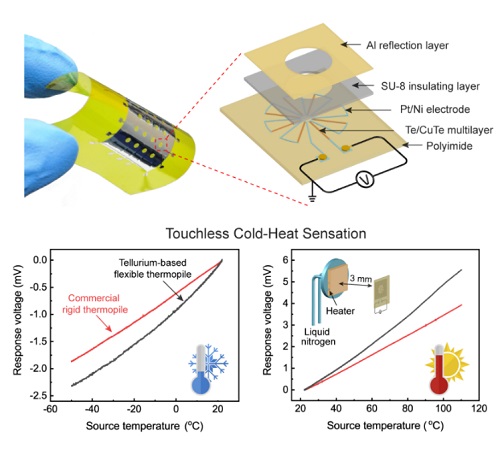Biomimetic tactile is a fundamental means for intelligent robots to perceive external environmental stimuli.
For traditional tactile sensors, direct physical contact with the thermal source was required to obtain the temperature information. However, such contact operating mode had a notable shortcoming: the potential physical damage when processing noxious thermal stimuli.
Therefore, it is necessary to develop the non-contact temperature perception function of e-skin for soft robotics and other interactive technologies.
Recently, a research team led by Prof. JIANG Peng, Associate Prof. LU Xiaowei, and Prof. BAO Xinhe from the Dalian Institute of Chemical Physics (DICP) of the Chinese Academy of Sciences (CAS) developed a flexible and wearable long-wave infrared detector, which enabled touchless thermosensation function of electronic skin.
This study was published in Advanced Materials on March 8.

A flexible wearable photothermoelectric detector enables touchless thermosensation over a broad source temperature range from –50 to 110°C (Image by GUO Xiaohan and LU Xiaowei)
Photothermoelectric (PTE) detectors, based on the combination of photothermal and thermoelectric conversions, can realize ultra-broadband photodetection without requiring cooling and external bias. They are particularly suitable for bionic applications involving infrared detection.
In this study, the researchers developed a flexible and wearable infrared detector by coupling the Te/CuTe thermoelectric heterostructure and the infrared-absorbing polyimide (PI) substrate. They found that the Te/CuTe thermoelectric heterostructure could reduce the noise equivalent power by improving the power factor. Moreover, they realized efficient PTE coupling by suppressing the optical reflection loss and aligning the destructive interference position with the absorption peak of the PI substrate, which improved the performance of PTE detector.
Besides, the researchers investigated the performance of PTE detector. They proved that when the temperature of the thermal source varied from –50 to 110°C, the fabricated flexible PTE detector, in the contactless mode, exhibited higher sensitivity than the commercial rigid thermopile. With this wearable infrared detector, they established a temperature pre-warning system for a soft robotic gripper that could distinguish the noxious thermal stimulus in a dynamic and contactless manner.
"This work provides a feasible strategy to integrate the infrared detection technique into the sensory modality of electronic skin, exhibiting great potential for smart robotics, artificial intelligence, and augmented reality," said Prof. JIANG
The above work was supported by the National Natural Science Foundation of China, the National Key R&D Program of China, the Natural Science Foundation of Liaoning Province, the CAS Interdisciplinary Innovation Team, and DICP.